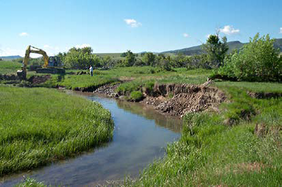River Restoration
Geomorphic assessment
Channel surveys
Hydrologic assessment
Hydraulic modeling
Habitat enhancement
Bank stabilization
Channel restoration
Bioengineering
Construction supervision

Biota uses a holistic approach to accomplishing river restoration projects. Rather than simply patching the visible symptoms of underlying problems, we rectify the causes and effects of degradation and instability in riverine systems by utilizing professional experience, progressive assessment methodologies, sound scientific analyses, and innovative design approaches.
Biota has worked with local, state, and federal governments, non-profit organizations, private landowners, and regulatory agencies to develop cost-effective solutions to restoration needs. Our experience and expertise in morphologic assessment, topographic and hydrologic data collection, sediment transport calculations, hydraulic modeling, and natural channel design principles allow us to design restoration treatments, supervise construction, and implement management strategies that ensure the success of our restoration and enhancement efforts.
Biota has worked with local, state, and federal governments, non-profit organizations, private landowners, and regulatory agencies to develop cost-effective solutions to restoration needs. Our experience and expertise in morphologic assessment, topographic and hydrologic data collection, sediment transport calculations, hydraulic modeling, and natural channel design principles allow us to design restoration treatments, supervise construction, and implement management strategies that ensure the success of our restoration and enhancement efforts.

Biota has provided consulting services related to channel stabilization, restoration, and riverine enhancement in the Intermountain West for three decades. We have an established reputation as a detail-oriented, professional, and highly qualified team that often obtains grants or other funding resources for our restoration projects. We recognize the importance of such projects in the context of restoring vital channel processes, maintaining essential habitat for native flora and fauna, increasing aesthetic value, and ensuring recreational opportunities for the future.
